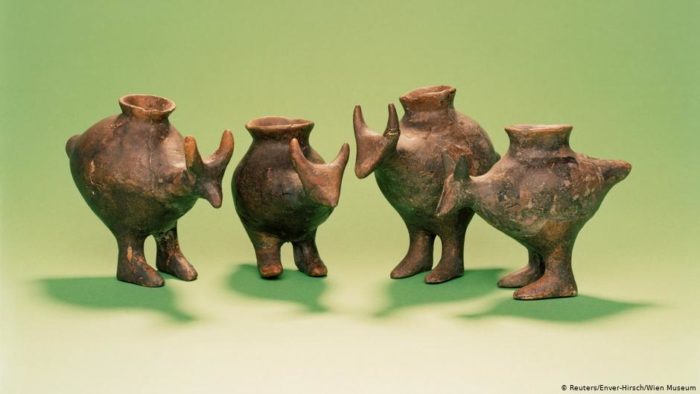
Prehistoric ceramic vessels were most likely used as baby bottles to feed infants animal milk, archaeologists confirmed Wednesday in one of the first examples ever discovered of how prehistoric people fed infants.
The objects, some of which were shaped into animal forms, were unearthed from infant burial grounds dating back to the Bronze and Iron Age located in modern-day Bavaria in southeast Germany.
The study, which was published in the scientific journal Nature, found “evidence of the foodstuffs that were used to either feed or wean prehistoric infants,” which “confirm the importance of milk from domesticated animals” for prehistoric groups of humans.
Archaeologists say little is known about which foods infants consumed in prehistoric times.
Researchers said the oldest of the three vessels examined in the study was made during the Bronze Age between 2,800 and 3,200 years ago.
“I think this has provided us the first direct evidence of what foods babies were eating or being weaned on to in prehistory,” said Julie Dunne, the lead author of the study and a biomolecular archaeologist at the University of Bristol in Britain.
“I think this shows us the love and care these prehistoric people had for their babies.”
Read more: Bronze Age regicide? German forensics team say prince of Helmsdorf was murdered
‘Incredibly cute’
The bowl-like objects had narrow spouts and were small enough to fit into a baby’s hands. Some were shaped like animal heads with horns, long ears and feet.
“I find them incredibly cute. And prehistoric people may have thought so,” archaeologist Katharina Rebay-Salisbury of the Austrian Academy of Sciences, told Reuters news agency.
“They would certainly have a dual function of entertaining the children just like modern stuffed animals,” she added.
Read more: Nuremberg archaeologists restore rare Bronze Age chariot burial artifacts
Rebay-Salisbury added that life was difficult in Europe during the Bronze Age and the Iron Age, with many people suffering from famine, disease and unhygienic living conditions.
An estimated third of all newborns died before their first birthday and only about half of children reached adulthood, Rebay-Salisbury said.
Plunderers thoroughly looted most of the bodies following the battle, but they missed these gold rings. Though they may shine in their original glory today, they still bear – symbolic – traces of blood. The special exhibition “Bloody Gold – Power and Violence in the Bronze Age” ran until September 18, 2018 in the Gross Raden Archaeological Open Air Museum.
The battle in the Tollense River Valley was one of life or death. This image shows a selection of bronze arrow tips that have been discoveredon the site. Around 90 percent of the battlegrounds in the region in Mecklenburg-Western Pomerania have yet to be dug up by curious archaeologists.
Apparently, this young man did not see death coming his way. This image shows why: An arrow pierced the back of his head. The bronze arrow tip is still stuck in the skull, thereby relaying a story over 3,000 years old.
It may be hard to believe, but this delicately designed bracelet was worn by a man. The bracelet was found in a man’s grave discovered in Promoisel. Only one other such ring has ever been found – on the Danish island of Bornholm.
This bronze belt purse is clearly a feminine fashion accessory. But since only the skeletons of men have been found at the battlegrounds in the Tollense River Valley, it is possible that this was a sacrificial offering that sunk in the river following the battle. But maybe someone also just lost it. Some mysteries may never be solved.
This “Horn of Wismar” is not an artifact from the battle on the riverbanks of the Tollense River, but it was manufactured around the same time. This magnificent specimen has metal fittings on which soldiers are depicted who are carrying spears and shields. The horn was discovered more than 100 years ago near Wismar.
The special exhibition “Bloody Gold” at the Gross Raden Open Air Museum presents the complete contents of several graves. One of those includes the chieftain’s grave of Crivitz, which also contained this gold brooch. Only eight such brooches have been discovered thus far, most of them in Denmark.
This image shows an interesting mixture of symbols of both beauty and violence: a sword, a bracelet, a tutulus and two sickles from the Tollense River Valley. The Bronze Age was in no way a period free of violence, yet people also preoccupied themselves with beautiful things such as arts and crafts.
The four little bronze spirals were parts of garments people wore over 3,000 years ago. Researchers identified the two metal rings as merchandise that was traded. All of these objects were found in the Tollense River Valley.
wmr/se (AFP, Reuters)
Every day, DW’s editors send out a selection of the day’s hard news and quality feature journalism. You can sign up to receive it directly here.
US, UK and Australian officials want Facebook to give authorities a way to read encrypted messages sent by ordinary users. Law enforcement has long sought access despite pushback from tech giants and privacy advocates.
After announcing a multibillion-dollar fiscal reform package, President Lenin Moreno is now facing street protests and transport strikes. The reform measures are aimed at improving the country’s economic revenue.
Despite facing an impeachment inquiry for asking Ukraine to investigate the Bidens, Donald Trump has now called on China to do the same. Democrats have accused the president of breaking his oath of office.
